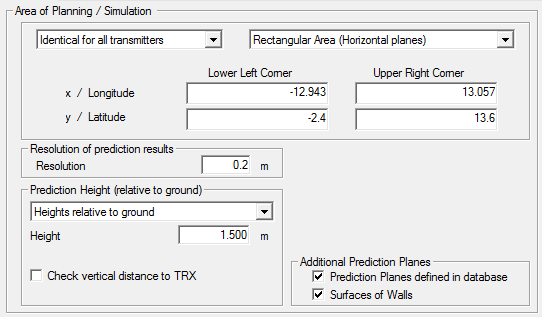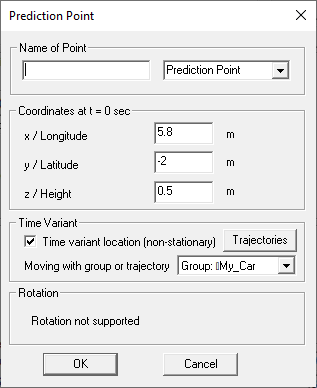Simulation Settings
The simulation can be configured by specifying the area of planning, the resolution of prediction results, prediction height and whether additional prediction planes are defined in the database.
Click to open the Edit Project Parameter dialog. The simulation settings are available on the Simulation tab.
Area of Planning / Simulation

- Prediction (simulation area)
-
- Individual for each transmitter
- The simulation area can be defined as a superposition of individual prediction areas defined separately for each transmitter/cell. These individual prediction areas can be defined on the Transmitter definition tab of the corresponding transmitter.
- Identical for all transmitters
-
- Rectangular area (Horizontal planes)
- The rectangular simulation area can be specified
by defining the lower-left and upper-right corner
coordinates. Another option is to use the
 Prediction Rectangle
(Rectangle) icon on the Project
toolbar, which allows you to draw a rectangle with
the mouse.
Prediction Rectangle
(Rectangle) icon on the Project
toolbar, which allows you to draw a rectangle with
the mouse. - Multiple Points (Arbitrary Heights)
-
Specify the individual prediction / receiver , reference or user points.
- Prediction Point
- Define a point at which a prediction is to be calculated. A prediction point is indicated by a square with a red outline.
- Reference Point
- Define a point that is always visible on the
map. A reference point is indicated by a red
X
. - User Point
- Define a point that represent a stationary or moving user. A user point is considered for the 5G beam switching. The name of the point can be shown/hidden, see Display Settings.
A set of prediction / receiver points can be imported from a .txt or a .csv file, and exported to a .txt file. When importing from a .csv file, a dialog will enable you to specify columns.Tip: When importing from a .csv file, you have the option to include a column with measured results. The measured results will not show up in the result tree, but a result file will be placed in the results folder. This is convenient to visualize independent results and compare them against WinProp results, for example, via menu.The prediction points can be moved by specifying a translation vector.Figure 2. The Prediction Point dialog. 
To move a prediction point with a moving object group or along a trajectory, select the Time variant location (non-stationary) check box.
- Multiple Trajectories
- Trajectories can be selected and edited. A trajectory selected at this stage is called a prediction trajectory and will be colored red. Although a receiving antenna pattern with appropriate orientation will be considered at every point of the trajectory, a receiving antenna will not move as a function of time along such a trajectory. Instead, received power along the entire trajectory will be computed at every time step. The combination of time-variant scenarios and prediction trajectories is a rare use case. Constant prediction areas and moving prediction points are more common in combination with time-variance.
- Resolution of prediction results
- The resolution grid of the result matrix can be changed only if the database was not preprocessed in area mode. It defines the size of the result pixels used for display.
- Prediction Height
-
The height of horizontal prediction planes can be defined relative to the ground level, absolute to sea level or relative to defined floor levels.
For prediction heights relative to ground, the height of interest is location-dependent. A typical example is where a person is walking in a hilly area with a cell phone.
For prediction heights absolute to sea level, the height of interest is fixed and does not follow the terrain. A typical example is where an aircraft flies at 1500 m.
Settings related to radio network planning simulations are only available for network projects. Some of the general simulation parameters depend on the selected air interface.